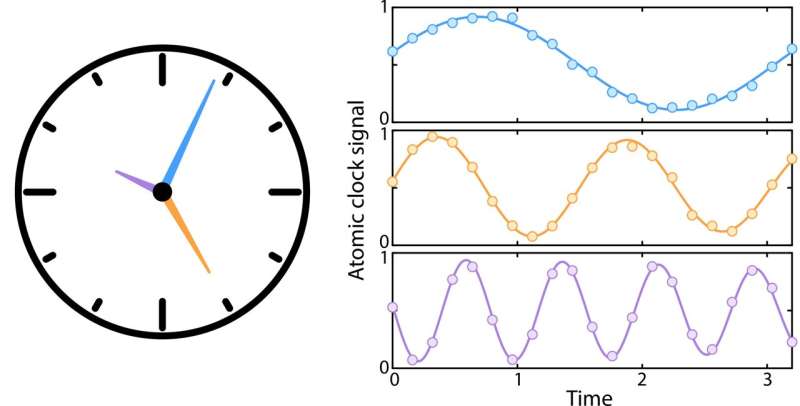February 12, 2024 feature
This article has been reviewed according to Science X's editorial process and policies. Editors have highlighted the following attributes while ensuring the content's credibility:
fact-checked
peer-reviewed publication
trusted source
proofread
A multi-ensemble atomic clock enhanced using quantum computing tools

Atomic clocks are a class of clocks that leverage resonance frequencies of atoms to keep time with high precision. While these clocks have become increasingly advanced and accurate over the years, existing versions might not best utilize the resources they rely on to keep time.
Researchers at the California Institute of Technology recently explored the possibility of using quantum computing techniques to further improve the performance of atomic clocks. Their paper, published in Nature Physics, introduces a new scheme that enables the simultaneous use of multiple atomic clocks to keep time with even greater precision.
"Atomic clocks are decades old, but their performance improves every year," Adam Shaw, co-author of the paper, told Phys.org.
"At the same time, in recent years there has been a major push in the atomic physics community to develop so-called quantum computers, devices which control the quantum states of individual atoms to carry out calculations beyond the capabilities of a normal computer. While clocks and computers are seemingly quite different, in recent years people have realized that they can be highly synergistic."
The key objective of the recent study by Shaw and his colleagues was to use some of the tools underlying the functioning of quantum computers to enhance atomic clocks. To do this, the researchers experimentally realized a 10-year-old theoretical proposal, which entails the simultaneous use of multiple clocks to keep time better than a single clock would, by ensuring that each of them records the passing of time at different rates.
"The idea is basically the same as having multiple hands on a watch: an hour hand to keep track of longer time changes and a minute hand to more precisely keep track of shorter time changes," Shaw explained. "What we have done is essentially build such a multi-hand clock at the atomic scale. To do so, we demonstrate a new way of controlling the electronic state of individual atoms with very high fidelity by changing their positions in a laser beam."
The researchers used their proposed technique to control individual atoms in atomic clocks. Specifically, they ensured that each atom effectively experienced the passing of time slower or faster, depending on their dynamic position in relation to the applied laser beam.
"The current most precise clocks in the world work by measuring the passage of time with a large ensemble of atoms, but we demonstrate that individual control could lead to better performance," Shaw said. "More generally, our work shows the power of combining the features of quantum computers and quantum sensors, a union which many other groups are working to achieve and improve upon."
The initial findings gathered by Shaw and his colleagues are very encouraging, highlighting the potential of quantum computing techniques in metrology research. In the future, this study could inspire the development of other programmable quantum optical clocks that yield even better performances.
A week after the team published their paper, another research group led by Shimon Kolkowitz at Berkeley published a paper attempting to realize a similar multi-hand clock in Physical Review X. Their multi-hand clock was created using a different technique, yet it also highlights the advantages of relying on more than one atomic clock at a time.
"In our recent paper, we controlled multiple individual atomic clocks, but the clocks themselves were relatively simple: just single atoms," Shaw added.
"We are now working to use quantum entanglement between individual atoms within each clock so that each 'hand' on our atomic watch becomes more precise. Doing so should improve clock performance and would be a true hybrid of a quantum computer and an atomic clock."
More information: Adam L. Shaw et al, Multi-ensemble metrology by programming local rotations with atom movements, Nature Physics (2024). DOI: 10.1038/s41567-023-02323-w.
Xin Zheng et al, Reducing the Instability of an Optical Lattice Clock Using Multiple Atomic Ensembles, Physical Review X (2024). DOI: 10.1103/PhysRevX.14.011006.
Journal information: Nature Physics , Physical Review X
© 2024 Science X Network





















